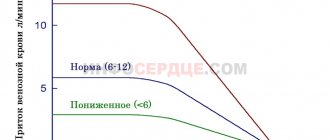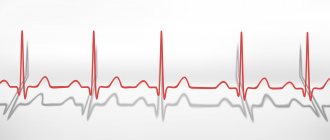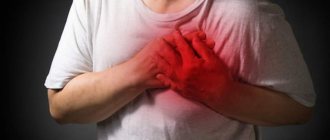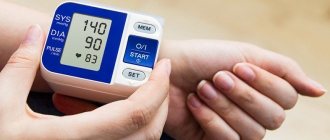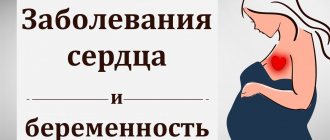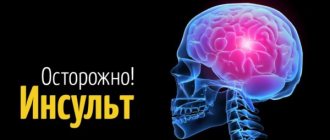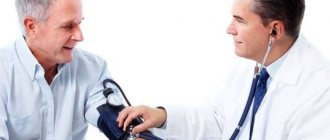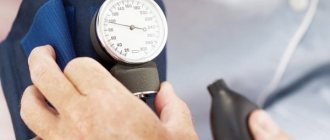Everything about blood pressure, what is normal blood pressure. Blood pressure, the norm for age, determines whether a person is healthy or not. So what is the ideal blood pressure according to age?
Blood pressure and pulse are one of the most important aspects of a healthy person. Any fluctuations in the norm indicate the presence of serious health problems, and you should immediately make an appointment with a specialist (cardiologist).
Normal blood pressure according to age is a set of indicators of the functioning of the human cardiovascular system, which completely influence the quality of life.
It is important to remember that both decreased and increased indicators entail a variety of diseases and pathologies.
We all know from medical sources that the norm is 120 (upper) by 80 (lower) millimeters of mercury, where the value of the number 120 is the contractions of the heart muscle, and 80 is the pressure of the heart at rest. The difference between these values is the pulse pressure, the norm of which fluctuates within 35 mmHg. Blood pressure and pulse are interrelated values, so heart rate (HR) is 60-90 beats per minute.
But these norms have blurred boundaries, since a person is influenced by various life factors, namely the following factors influence the result:
- force of movement of venous blood;
- individual blood composition indicators;
- blockage of blood vessels;
- level of vascular elasticity;
- sharp contraction of blood vessels;
- thyroid condition;
- level of hormones in the blood.
Does heart rate depend on blood pressure and how are they related?
The flow of blood through the vessels is uneven. Its movement occurs in jerks, thanks to heart contractions.
The dependence of the pulse on blood pressure is that the greater the volume of blood entering the heart, the faster it contracts and vice versa.
Rhythm, the number of heartbeats, as well as pressure indicators, affect a person’s well-being . They can be individual symptoms, for example: tachycardia, bradycardia, arrhythmia, or signal another disease.
There are generally accepted norms for blood pressure and heart rate. If there are deviations, the patient is sent for additional diagnostics.
Cardiovascular activity and medication use
Practical medicine uses many drugs that directly or indirectly affect the tone of the vascular wall, the functioning of the myocardium, as well as the brain centers responsible for the functioning of the circulatory system.
Moreover, these drugs can exhibit cardiotropic and vasoregulatory effects, causing not only the main, but also an undesirable side effect. The dependence of pulse and blood pressure on the use of non-selective adrenergic blockers was revealed.
When using adrenergic blockers as antihypertensive drugs, patients experience a slowdown in rhythm, up to the development of blockades.
That is why, for hypertensive patients with bradyarrhythmia, the use of cardioselective beta-blockers, which affect only the vascular wall, is indicated. It should be noted that drugs that suppress the activity of the parasympathetic nervous system (anticholinergics) give an effect similar to stimulation of the sympathetic system.
Drugs such as Caffeine, Lobelin, Cititon can cause tachycardia and a hypertensive state.
What indicators are considered normal, high, low?
| Age | Pulse is normal | |
| men | women | |
| 1-10 | 70-120 | 70-120 |
| 10-20 | 60-130 | 70-110 |
| 20-40 | 50-90 | 60-70 |
| 40-60 | 60-85 | 75-83 |
| More than 60 | 70-90 | 80-85 |
| Age | Minimum normal pressure reading | Maximum normal pressure reading | ||
| men | women | men | women | |
| 1-10 | 100/60 | 100/60 | 120/78 | 120/78 |
| 10-20 | 115/70 | 110/70 | 134/83 | 138/85 |
| 20-40 | 117/77 | 110/70 | 137/87 | 132/83 |
| 40-60 | 120/82 | 112/79 | 144/90 | 137/87 |
| More than 60 | 145/78 | 144/82 | 147/83 | 159/91 |
| Age | Blood pressure mm Hg. Art. | |||
| Systolic | Diastolic | |||
| Min | Max | Min | Max | |
| up to 2 weeks | 60 | 96 | 40 | 50 |
| 2-4 weeks | 80 | 112 | 40 | 74 |
| 2-12 months | 90 | 112 | 50 | 74 |
| 2-3 years | 100 | 112 | 60 | 74 |
| 3-5 years | 100 | 116 | 60 | 76 |
| 6-9 years | 100 | 122 | 60 | 78 |
| 10-12 years | 110 | 126 | 70 | 82 |
| 13-15 years old | 110 | 136 | 70 | 86 |
How do they change depending on age?
With age, blood pressure gradually increases.
- Young children do not need many resources; therefore, their pulse and blood pressure are lower than those of adults. During puberty, the situation changes; the production of hormones provokes an increase in heart rate and a decrease in blood pressure.
- In the period between 20-45 years, blood pressure and heart rate are closely related to lifestyle. They can increase or decrease due to concomitant diseases, bad habits, and physical activity.
- After 50 years, natural aging of the body begins. Most people at this time experience a slow heart rate and hypertension. This is due to the fact that the vessels lose their tone and ability to fully supply blood to the heart.
After waking up, the heart rate for all people is at its lowest value, and in the evening, due to overexcitation of a person, the indicators increase.
Men have a larger heart, so their performance is somewhat different from that of women . Pulse values in women are always higher, because the small heart muscle needs more contractions to pump the same volume of blood.
Changes in blood pressure and heart rate are observed during pregnancy. In the first trimester, heart rate increases by 15-20 beats/min, and blood pressure decreases. Immediately before birth, all indicators return to normal.
Dependence of pulse on pressure
The pulse refers to the vibration of the walls of blood vessels, which occurs as a result of contractions of the heart muscle. Using this parameter, you can assess not only the condition of the organ for the rhythm and strength of the heartbeat, but also determine the overall vascular tone.
In a healthy person, the intervals between pulsations, equal to the frequency of heart contractions, must be uniform, otherwise a violation of rhythm may indicate possible pathologies of the cardiac and vascular systems.
The tonometer readings are directly related to the heartbeat; accordingly, the ratio of pulse and arterial blood pressure is determined by the condition of one organ - the heart.
The ideal ratio between diastolic and systolic pressure relative to the pulse is considered to be 120 to 80 mmHg. and 70-80 blows in 60 seconds.
The heart rate, which is reflected by the pulse, depends on the filling of the vessels and the blood volume released into them.
Don't tolerate high blood pressure
Now hypertension can be cured by restoring blood vessels...
>
A sharp increase in blood pressure against the background of an increasing pulse indicates the risk of developing a hypertensive crisis, requiring immediate medical intervention. Also in medical practice, an increase in heart rate is observed against the background of low tonometer readings, which is much less common.
Since the dependence of pulsation frequency on blood pressure is explained by an increase in the former due to an increase in the latter, it is important to carry out all measurements at rest.
Often, an increase in blood pressure, which entails a sharp increase in heart rate, is caused by sudden emotional surges and physical exertion.
How to measure?
Heart rate and blood pressure levels are the main indicators in the diagnosis of all diseases. They are measured very simply - using a tonometer.
Not everyone knows how pulse and blood pressure are related. However, blood pressure can be determined by measuring the number of heartbeats. If there is no special device nearby, take a thread, a ruler and a regular ring .
- A ruler at least 20 cm long is placed so that the 0 mark is on the wrist.
- The ring is put on a thread and brought to the ruler.
- Lead with a thread with a ring from 0 to 20.
At a certain point, the improvised pendulum will begin to move.
This figure is multiplied by 10. This figure will indicate the diastolic pressure. To obtain the second indicator, continue to move the pendulum along the ruler. The second number on which the pendulum will move is also multiplied by 10. It is the upper figure. Of course, these results are very approximate, but in a critical situation even they can help.
To measure your heart rate, just feel the place on your temples, neck or wrist where the pulsation is best heard. Record a minute on the clock and count the number of contractions.
What does heart rate mean?
Pulse refers to the frequency of heart contractions.
In other words, these are jerky vibrations of the vascular walls with a certain periodicity, caused by the movement of blood when it is ejected by the heart at the moment of systole. In medicine, the most common practice is to determine the arterial pulse as one of the important informative sources of a person’s health status.
It is recommended to measure heart rate when the patient is in a calm, relaxed state. This is explained by the fact that the intensity of pulse beats can vary greatly in both directions - slowing down or speeding up during physical and other stress of the body.
The counting is carried out within 30 seconds, but if the rhythm is not sufficient, the counting is increased to 1 minute.
What do pathological indicators indicate?
- Tachycardia and low blood pressure occur as a consequence of dysfunction of the autonomic nervous system, diabetic nephropathy, amyloidosis or varicose veins. Other possible reasons for the development of this condition include:
- stomach ulcer;
- anemia;
- sepsis;
- oncological formations;
- atherosclerosis;
- meningitis;
- encephalitis;
- pericarditis;
- embolism
- Low blood pressure and high pulse occur due to improper use of diuretics, nitro drugs, and angiotensin II inhibitors.
- A slow pulse with reduced blood pressure is observed as a consequence of myocardial inflammation, excess potassium in the body, tumors in the brain, diabetes mellitus, congenital pathologies of the heart and blood vessels.
- Sometimes a similar clinical picture is observed with bleeding and internal hemorrhages. If a person is in a pre-infarction state, he also experiences bradycardia and hypotension.
- Pulse failure at normal pressure develops after taking certain medications, chemical poisoning, or dehydration. In pregnant women, this condition threatens premature placental abruption.
- Bradycardia occurs during hypothermia.
- An increased number of heartbeats with high blood pressure is quite understandable, because the faster the heart works, the faster blood circulates throughout the body. But there are situations when the patient requires immediate hospitalization. Tachycardia and high blood pressure are characteristic of:
- hypertension;
- ischemia;
- atherosclerosis;
- thrombosis;
- thyroid diseases.
- Most often, high heart rate and high blood pressure occur in obese people who abuse alcohol and suffer from iron deficiency anemia.
- An increased pulse and normal blood pressure indicate the presence or development of diseases such as hyperthyroidism, asthma, bronchitis, and anemia. In most cases, after treatment of the underlying disease, heart rate returns to normal.
- Elevated heart rate with normal blood pressure can be caused by prolonged exposure to an uncomfortable position, a depressed emotional state, a state of fear, anxiety, elevated air temperature, and physical activity.
- Bradycardia against the background of hypertension appears due to congenital defects of the cardiovascular system or age-related changes. Often the cause is untreated infectious diseases, meningitis, encephalitis, and head injuries.
Hell heart rate control what is it
Heart rate is the number of heart contractions per unit of time (usually per minute). It is believed that heart rate is the same as pulse, but it is not.
How does heart rate differ from pulse?
As already mentioned, heart rate shows how many contractions the heart makes, namely its lower parts - the ventricles - per minute.
The pulse, or heart rate, is the number of times the artery dilates as the heart pumps blood per minute. Blood passing through the vessels during the contraction of the heart creates a bulge in the arteries, which is determined by touch.
The pulse value and heart rate can indeed be equal, but not always, but only in healthy people.
For example, with rhythm disturbances, the heart contracts erratically. If it contracts twice in a row, then the left ventricle does not have time to fill with blood. Thus, the second contraction occurs when the ventricle is empty and no blood is ejected from it into the aorta and peripheral vessels.
Therefore, the pulse in the arteries will not be heard while the heart is contracting. With atrial fibrillation and some other diseases, the heart rate does not correspond to the pulse rate. This phenomenon is called pulse deficit. In such cases, heart rate cannot be determined by measuring the pulse.
This can only be done by listening to the heartbeat, for example using a phonendoscope.
Normal heart rate in adults ranges from 60 to 80 beats per minute. If the frequency is less than 60, it is bradycardia, if above 80, it is tachycardia.
Resting heart rate will vary depending on:
- person's age;
- his gender;
- body size;
- fitness.
In newborns, this figure is usually 120-140 beats per minute. If the child is premature, the value will be higher - from 140 to 160. In children by one year it decreases to 110-120, by five years - to 100, by 10 - to 90, by 13 - to 80.
In a trained person, the heart rate is lower than normal and averages about 50, while in those leading a sedentary lifestyle it can reach 100 beats at rest.
In women, the heart rate is approximately 6 beats higher than in men, and increases even more before the onset of menstruation.
When it changes
The value is not the same at different times of the day. The indicator changes throughout the day depending on the following factors:
- during physical activity;
- in moments of anger, fear, excitement and other emotions;
- depending on body position (lying, sitting, standing);
- after eating;
- after taking certain medications.
The heart rate increases after eating food, especially hot and protein foods.
When body temperature rises to 37 degrees, it increases by 20 beats.
During sleep it decreases by five to seven units.
Heart rate increases by about 10% when a person is sitting and by 20% when standing.
- when in a stuffy, hot room;
- during stress;
- during physical activity.
Causes of tachycardia and bradycardia
If your heart rate at rest is not normal, this may be a sign of illness. Usually, other manifestations of the disease are also present.
If tachycardia is accompanied by symptoms such as dizziness, shortness of breath, weakness, fainting, then the following cannot be ruled out:
- infectious disease;
- heart disease;
- onset of stroke;
- endocrine disorders;
- diseases of the nervous system;
- tumor processes;
- anemia.
Bradycardia can normally be observed in the following cases:
- for athletes (40 strokes);
- in people engaged in heavy physical labor;
- when taking certain medications.
It can also be a sign of illness:
- poisoning;
- heart attack;
- stomach ulcers;
- hypothyroidism;
- myocardial inflammation.
How to measure
Heart rate is measured at rest in a quiet and warm room. To carry out the procedure, you will need a stopwatch and an assistant. Approximately an hour before the measurement, you need to eliminate physical and emotional stress and smoking. It is not recommended to take medications or drink alcoholic beverages.
The person whose heart rate will be measured can lie down or sit down. After he takes the desired position, you need to lie down or sit quietly for five minutes.
The assistant places a clean, dry palm on the chest below the left nipple for a man and under the mammary gland for a woman.
It is necessary to determine the impact on the chest at the apex of the heart, which is called the apical impulse. It is heard in half of healthy people in the fifth intercostal space if the person is standing. If you can’t determine it, it means it falls on an edge.
After this, you need to take a stopwatch and start counting the person’s heartbeats for a minute. If the rhythm is incorrect, you need to do this for three minutes, then divide the resulting number by three.
Heart rate can be measured in other places, where the arteries come close to the surface. The pulsation is clearly palpable:
When measuring your pulse, to get more accurate results, you need to do it on both sides of the body.
Maximum heart rate
This is the highest number of beats per minute that the heart can make. This indicator is used by athletes to know what maximum load the heart can be subjected to.
It is best to determine the maximum heart rate clinically, that is, this should be done by a cardiologist using a treadmill and an electrocardiograph.
There is another simplified way to find out the capabilities of your heart, but the result will be approximate. Maximum heart rate is determined by the formula:
- for men – 220 minus age;
- for women – 226 minus age.
Conclusion
Heart rate is an important indicator of heart function. Like heart rate, it is widely used in medicine for diagnostic purposes, as well as in sports to monitor the intensity of training.
Does heart rate depend on blood pressure? Measurement and norms of these indicators, treatment and prevention
When we visit a therapist, he first of all measures blood pressure and pulse, since these are the indicators that can provide basic information about the general condition of the patient. The text talks about the effect of blood pressure on heart rate, the norms of these indicators, how to measure them and keep them normal.
Does heart rate depend on blood pressure and how are they related?
The flow of blood through the vessels is uneven. Its movement occurs in jerks, thanks to heart contractions.
The dependence of the pulse on blood pressure is that the greater the volume of blood entering the heart, the faster it contracts and vice versa.
Rhythm, the number of heartbeats, as well as pressure indicators, affect a person’s well-being . They can be individual symptoms, for example: tachycardia, bradycardia, arrhythmia, or signal another disease.
There are generally accepted norms for blood pressure and heart rate. If there are deviations, the patient is sent for additional diagnostics.
How do they change depending on age?
With age, blood pressure gradually increases.
- Young children do not need many resources; therefore, their pulse and blood pressure are lower than those of adults. During puberty, the situation changes; the production of hormones provokes an increase in heart rate and a decrease in blood pressure.
- In the period between 20-45 years, blood pressure and heart rate are closely related to lifestyle. They can increase or decrease due to concomitant diseases, bad habits, and physical activity.
- After 50 years, natural aging of the body begins. Most people at this time experience a slow heart rate and hypertension. This is due to the fact that the vessels lose their tone and ability to fully supply blood to the heart.
Source: https://baby-clinic-vozr.ru/lechenie/kontrol-ad-chss-chto-eto-takoe.html
Treatment
- You can lower your heart rate without reducing your blood pressure by using drugs such as Glycine, Valocardine, Valerian and Corvalol. Be sure to take vitamins that improve the functionality of the heart muscle, for example, Riboxin, Asparkam, Magne B6.
- To normalize a low pulse, Atropine, Alupent, Ephedrine hydrochloride, Isoproterenol, Izadranin are prescribed. If there is no effect from the medications within a month, the patient is advised to have a pacemaker installed.
- The following will help raise your pulse and blood pressure: Alupent, Eufillin, Belloid, Cogitum and Doppelhertz. They speed up the work of the heart muscle, and accordingly blood pressure will increase. As an addition to medications, you can drink tincture of ginseng, eleutherococcus and lemongrass. They dilate blood vessels and improve blood circulation.
- The following will help lower your heart rate: Valerian, Persen, Phenobarbital, Relanium. These drugs perfectly reduce the number of heartbeats, but do not provide a hypotensive effect, therefore, to achieve an optimal effect, it is important to use them with drugs from the following groups:
- diuretics - Hypothiazide, Furosemide;
- ACE inhibitors - Renipril, Diroton;
- sartans – Lozap, Diovan;
- calcium channel blockers – Verapamil, Felodip;
- alpha and beta blockers - Cardura, Lokren, Concor.
- If the patient feels pressing pain in the chest, he may be prescribed analgesics.
How to maintain normal?
To prevent problems with the cardiovascular system, it is important to eat right . Avoid fried foods, salt, smoked meats, baked goods, animal fats, and processed foods. This food clogs blood vessels and also disrupts the functioning of the heart. Eat more fresh vegetables, fruits, and foods containing potassium and magnesium.
If you suffer from low blood pressure and bradycardia, you can increase them with some spices and coffee, but it is also not recommended to get carried away with them. People with hypotension and low heart rate should not skip breakfast - it gives a boost of energy for the whole day. 8 hours of sleep and increased physical activity are required.
You can reduce high blood pressure and pulse levels by calming down .
It is recommended to listen to relaxing music and watch the fish in the aquarium. Try to avoid stress and not overwork. Don't forget about relaxation and walks in the fresh air.
Prevention
Spend less time at the computer and TV.
Increase your physical activity. Cardio exercises will help people with low blood pressure and bradycardia to start their heart at a normal pace, and those who are obese will help get rid of extra pounds. Give up bad habits - the fleeting pleasure of alcohol and smoking is not worth your health.
In order to keep your body in ideal condition and not know what hypotension, hypertension, bradycardia is until old age, you need to take care of yourself from a young age.
If you have ignored sports your entire adult life, eating healthy and visiting doctors, not a single medicine can restore the full functioning of your internal organs. All that doctors can do is to reduce the intensity of the consequences of your neglect of your body.
